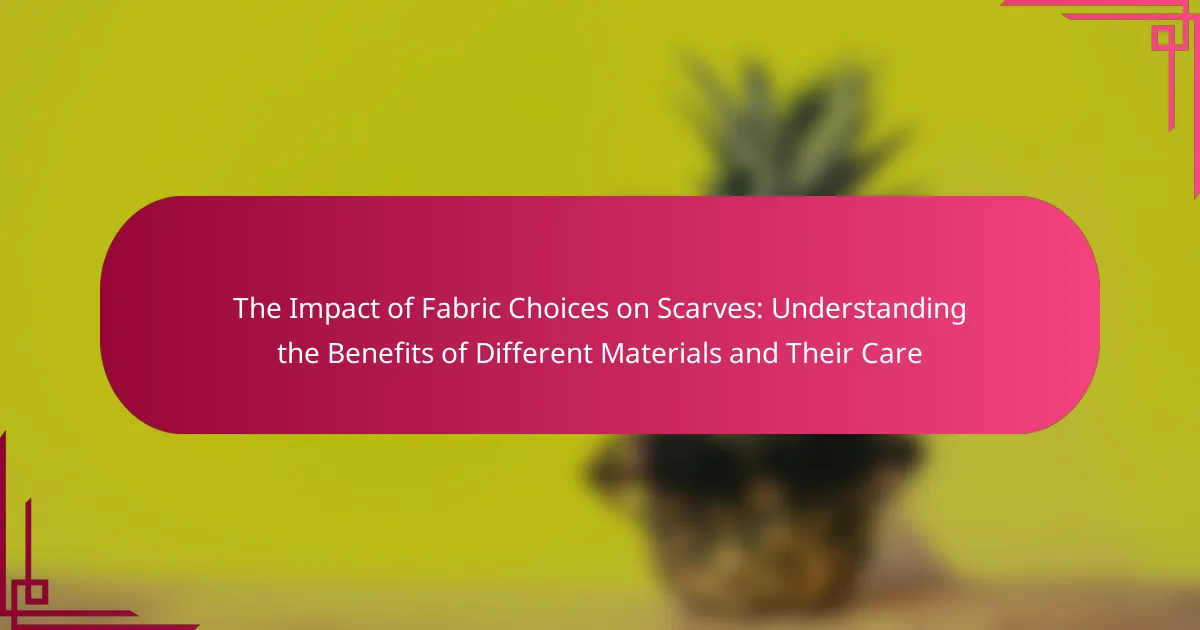Fabric choices play a crucial role in determining the quality, appearance, and functionality of scarves. Different materials, such as silk, wool, and cotton, provide unique textures, warmth levels, and care requirements, which significantly influence their use and maintenance. Understanding the specific characteristics of each fabric, including their durability and care instructions, is essential for preserving the scarf’s aesthetics and longevity. The article explores the benefits of various materials, the impact of texture and breathability on comfort, and the importance of informed fabric care to enhance the wearer’s investment in their scarves.

What is the impact of fabric choices on scarves?
Fabric choices significantly impact the quality, appearance, and functionality of scarves. Different fabrics offer various textures, weights, and warmth levels. For instance, silk scarves provide a luxurious feel and elegant drape. Wool scarves are known for their warmth and durability, making them ideal for colder climates. Cotton scarves are breathable and lightweight, suitable for warmer weather. The choice of fabric also affects care requirements. Silk may require dry cleaning, while cotton can often be machine washed. Additionally, the fabric’s ability to hold dye influences color vibrancy. Therefore, selecting the right fabric is essential for achieving desired aesthetics and practicality in scarves.
How do different materials influence the quality of scarves?
Different materials significantly influence the quality of scarves. Fabrics like silk offer a luxurious feel and natural sheen. They are lightweight and drape beautifully. Wool provides warmth and durability, making it ideal for colder climates. Cotton is breathable and easy to care for, suitable for casual wear. Synthetic materials like polyester can be more affordable and resistant to wrinkles. Each material affects the scarf’s texture, appearance, and longevity. For instance, silk scarves can last for years with proper care, while cotton may wear out faster. The choice of material ultimately determines the scarf’s functionality and aesthetic appeal.
What are the most common fabrics used in scarves?
The most common fabrics used in scarves are wool, cotton, silk, and polyester. Wool is favored for its warmth and durability. Cotton is lightweight and breathable, making it ideal for warmer climates. Silk offers a luxurious feel and a natural sheen. Polyester is often used for its affordability and ease of care. These fabrics are popular due to their unique qualities and versatility in fashion.
How does the texture of fabric affect scarf wearability?
The texture of fabric significantly affects scarf wearability. Softer fabrics, like cashmere and silk, provide comfort against the skin. This enhances the overall experience of wearing a scarf. In contrast, coarse textures, such as wool blends, may cause irritation or discomfort. The drape of the fabric also influences how the scarf falls and wraps around the body. Fabrics with a smooth texture tend to drape elegantly, while stiffer materials can create bulk. Additionally, the breathability of the fabric impacts wearability in different climates. Lightweight, breathable textures are ideal for warmer conditions. Heavier fabrics are better suited for colder weather, providing warmth and insulation. Therefore, the texture of fabric plays a crucial role in determining both comfort and functionality in scarf wearability.
What benefits do various materials offer in scarf production?
Various materials offer distinct benefits in scarf production. Wool provides warmth and insulation, making it ideal for colder climates. Cotton is breathable and lightweight, suitable for warmer weather. Silk offers a luxurious feel and natural sheen, enhancing the scarf’s aesthetic appeal. Linen is highly absorbent and quick-drying, perfect for humid conditions. Synthetic fibers like polyester are durable and resistant to wrinkles, ensuring longevity. Each material contributes unique properties that cater to different preferences and seasonal needs.
Which fabrics provide the best warmth and insulation?
Wool, fleece, and down are the fabrics that provide the best warmth and insulation. Wool has natural insulating properties and retains heat even when wet. Fleece is lightweight and offers excellent thermal retention. Down insulation is highly efficient, trapping air for warmth while remaining compressible. Studies show that wool can retain up to 80% of its insulating ability when damp. Fleece can be up to 50% warmer than cotton. Down is known for its high warmth-to-weight ratio, making it ideal for cold weather gear.
How do different materials contribute to scarf durability?
Different materials significantly influence scarf durability. Natural fibers like wool and silk offer resilience and longevity. Wool is known for its elasticity and ability to retain shape, making it resistant to wear. Silk provides a luxurious feel while being strong, though it may require careful handling to avoid damage. Synthetic fibers, such as polyester, are durable and resistant to fading and stretching. They can withstand frequent washing without losing integrity. Blended materials combine the strengths of both natural and synthetic fibers, enhancing durability. For example, a wool-polyester blend can offer warmth and strength. Overall, material choice is crucial in determining how well a scarf will endure over time.

Why is it important to understand fabric care for scarves?
Understanding fabric care for scarves is essential to maintain their appearance and longevity. Different fabrics have unique care requirements that affect their durability. For example, silk scarves need gentle hand washing to prevent damage. Wool scarves may require dry cleaning to avoid shrinking. Proper care ensures that colors remain vibrant and patterns stay intact. Neglecting fabric care can lead to irreversible damage, such as fading or fraying. Additionally, understanding care instructions helps in preserving the scarf’s shape and texture. Overall, informed fabric care enhances the wearer’s investment in their scarves.
What are the general care instructions for different scarf materials?
Silk scarves should be hand-washed in cold water with mild detergent. Avoid wringing or twisting the fabric to prevent damage. Lay flat to dry away from direct sunlight to maintain color vibrancy. Wool scarves require gentle hand-washing or dry cleaning. Use cool water and a wool-specific detergent. Air dry flat to avoid stretching. Cotton scarves can be machine washed in cold water. Use a gentle cycle and tumble dry on low heat. Linen scarves should be hand-washed in cold water to prevent shrinkage. Iron on a low setting while slightly damp for best results. Each material has specific care needs to ensure longevity and maintain appearance.
How does washing affect the longevity of scarf fabrics?
Washing affects the longevity of scarf fabrics by causing wear and tear over time. Frequent washing can lead to fabric fading, fraying, and loss of shape. Different materials react differently to washing. For example, delicate fabrics like silk may degrade faster than cotton. The temperature of the wash also plays a crucial role. Hot water can shrink and damage fibers, while cold water is gentler. Additionally, the type of detergent used can impact fabric integrity. Harsh chemicals may weaken fibers, leading to shorter lifespan. Proper washing techniques can mitigate these effects. Hand washing and air drying are often recommended for delicate scarves.
What are the best practices for storing scarves to maintain their quality?
To maintain the quality of scarves, store them in a cool, dry place. Avoid direct sunlight to prevent fading. Use a dedicated storage box or drawer to keep them organized. Fold scarves neatly to prevent creasing. If hanging, use padded hangers to avoid stretching. Ensure they are clean and dry before storage to prevent mold. For delicate fabrics, consider using acid-free tissue paper for extra protection. Regularly check stored scarves for any signs of damage or pests.
How can improper care affect scarf performance?
Improper care can significantly degrade scarf performance. Scarves made from delicate materials may lose their shape when washed incorrectly. For example, wool scarves can shrink if exposed to high temperatures. Silk scarves may become discolored or lose luster due to harsh detergents. Additionally, improper storage can lead to creases and wrinkles. These factors can affect the scarf’s appearance and functionality. Regular maintenance and proper cleaning methods are essential to preserve the scarf’s quality.
What are the signs of wear and tear in scarves due to poor maintenance?
Signs of wear and tear in scarves due to poor maintenance include fraying edges, discoloration, and pilling. Fraying edges occur when the fabric is not properly cared for or stored. Discoloration can result from exposure to sunlight or improper washing techniques. Pilling happens when fibers break down, often due to friction or low-quality materials. Additionally, stretched or misshapen areas indicate a lack of proper handling. These signs suggest that the scarf has not been maintained according to recommended care guidelines. Proper maintenance is essential for preserving the integrity and appearance of scarves.
How can fabric choices impact the ease of cleaning scarves?
Fabric choices significantly affect the ease of cleaning scarves. Natural fibers like cotton and linen are often easier to clean because they are typically machine washable and durable. Synthetic fabrics, such as polyester, can also be easy to clean but may require special care to avoid damage. Delicate materials like silk often need hand washing or dry cleaning, making them less convenient for maintenance. Stains on lighter fabrics are more visible, necessitating prompt cleaning to prevent permanent marks. In contrast, darker or patterned fabrics can hide stains better, reducing the frequency of cleaning. Overall, the choice of fabric directly influences the time and effort required for maintaining a scarf’s appearance.

What should you consider when choosing a fabric for a scarf?
Consider the fabric’s texture, warmth, and breathability when choosing a scarf. Texture affects comfort against the skin. Wool provides warmth and insulation. Cotton offers breathability and softness. Silk adds a luxurious feel and drapes well. Durability is also important for longevity. Some fabrics require specific care, influencing maintenance choices. Allergies to certain materials should be considered for skin safety. The intended use, such as fashion or function, guides fabric selection.
How do personal preferences influence fabric choice?
Personal preferences significantly influence fabric choice for scarves. Individuals often select fabrics based on comfort, texture, and aesthetic appeal. For instance, some may prefer soft, breathable materials like cotton for everyday wear. Others might choose luxurious fabrics such as silk for special occasions. Preferences can also be shaped by climate; warmer fabrics are favored in colder regions. Additionally, personal style plays a crucial role; bold patterns or colors may attract some, while others might opt for subtle designs. According to a study by the Fashion Institute of Technology, consumer choices are largely driven by emotional connections to fabrics. This highlights the importance of personal preferences in fabric selection.
What factors should be considered for seasonal scarf selections?
Seasonal scarf selections should consider fabric type, climate suitability, and style versatility. Fabric type influences warmth and breathability. Wool and cashmere provide warmth for colder months. Lightweight cotton or linen suits warmer seasons. Climate suitability ensures comfort; choose thicker materials for winter and lighter ones for summer. Style versatility allows scarves to complement various outfits. Patterns and colors should align with seasonal trends. Durability is also essential; select materials that withstand seasonal wear. Lastly, care requirements matter; some fabrics need special washing or storage.
How does the intended use of a scarf dictate fabric choice?
The intended use of a scarf significantly influences fabric choice. For instance, scarves intended for warmth typically use materials like wool or fleece. These fabrics provide insulation and retain heat effectively. Conversely, scarves designed for fashion may use lighter fabrics such as silk or cotton. These materials offer breathability and a smooth texture suitable for styling. Scarves for outdoor activities often utilize synthetic blends for durability and moisture-wicking properties. Each fabric choice aligns with the specific functional requirements of the scarf’s intended use. Thus, understanding the purpose of the scarf is essential in determining the most appropriate fabric.
What are the best tips for selecting the right scarf fabric?
Select scarf fabric based on the intended use and climate. For warmth, choose wool or cashmere. These materials provide excellent insulation. For breathability, opt for cotton or linen. These fabrics allow air circulation, making them suitable for warmer weather. Consider the fabric’s texture for comfort against the skin. Soft fabrics like silk offer a luxurious feel. Durability is also important; synthetic blends can enhance longevity. Pay attention to the fabric’s weight; lighter fabrics are better for layering. Lastly, check the care instructions to ensure easy maintenance. Fabrics like polyester are often machine washable, while delicate materials may require hand washing.
How can you determine the right fabric based on skin sensitivity?
To determine the right fabric based on skin sensitivity, identify the skin type first. Sensitive skin often reacts to certain materials. Opt for natural fibers like cotton or bamboo. These fabrics are breathable and hypoallergenic. Avoid synthetic materials such as polyester or nylon. These can cause irritation or allergic reactions. Conduct a patch test by placing a small fabric sample on the skin. Monitor for any adverse reactions over 24 hours. Consult dermatological guidelines which recommend soft, non-irritating fabrics for sensitive skin.
What are the key characteristics to look for in a high-quality scarf fabric?
Key characteristics to look for in a high-quality scarf fabric include softness, durability, and breathability. Softness ensures comfort against the skin, making the scarf pleasant to wear. Durability indicates the fabric’s ability to withstand wear and tear, ensuring longevity. Breathability allows for air circulation, making the scarf suitable for various climates. Additionally, high-quality fabrics often have a smooth texture and a rich color depth. Fabrics like silk, cashmere, and high-grade cotton are often preferred for their luxurious feel and appearance. These materials typically retain their shape and color over time, further enhancing their quality.
The main entity of this article is scarves, specifically focusing on the impact of fabric choices on their quality, functionality, and care. The article examines various fabrics commonly used in scarves, such as silk, wool, cotton, and polyester, highlighting their unique attributes, benefits, and maintenance requirements. It discusses how fabric texture influences wearability and comfort, the importance of understanding care instructions to extend longevity, and the factors to consider when selecting fabrics based on intended use and personal preferences. Furthermore, the article provides guidance on recognizing signs of wear and tear due to improper maintenance, emphasizing the significance of informed fabric care for preserving the quality of scarves.
